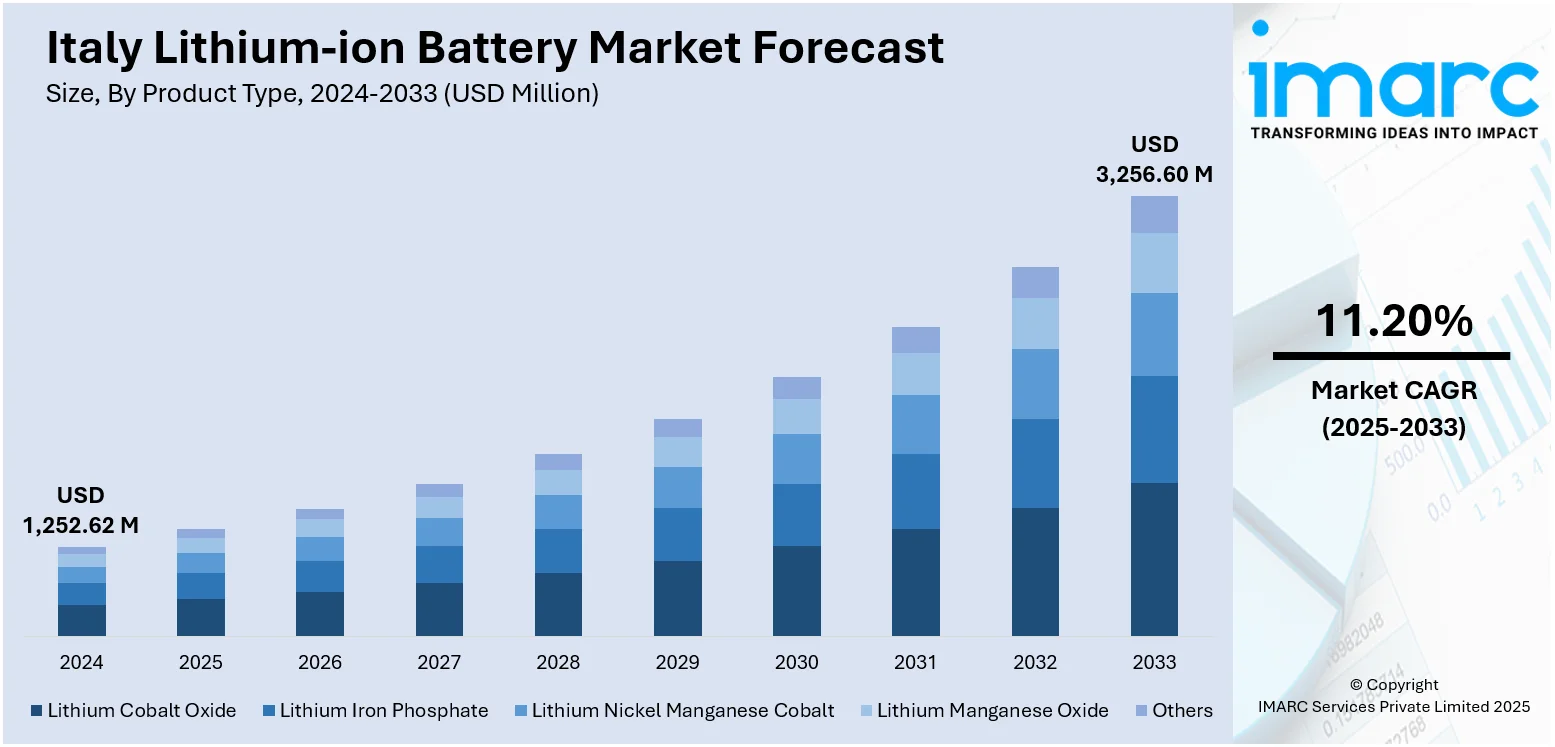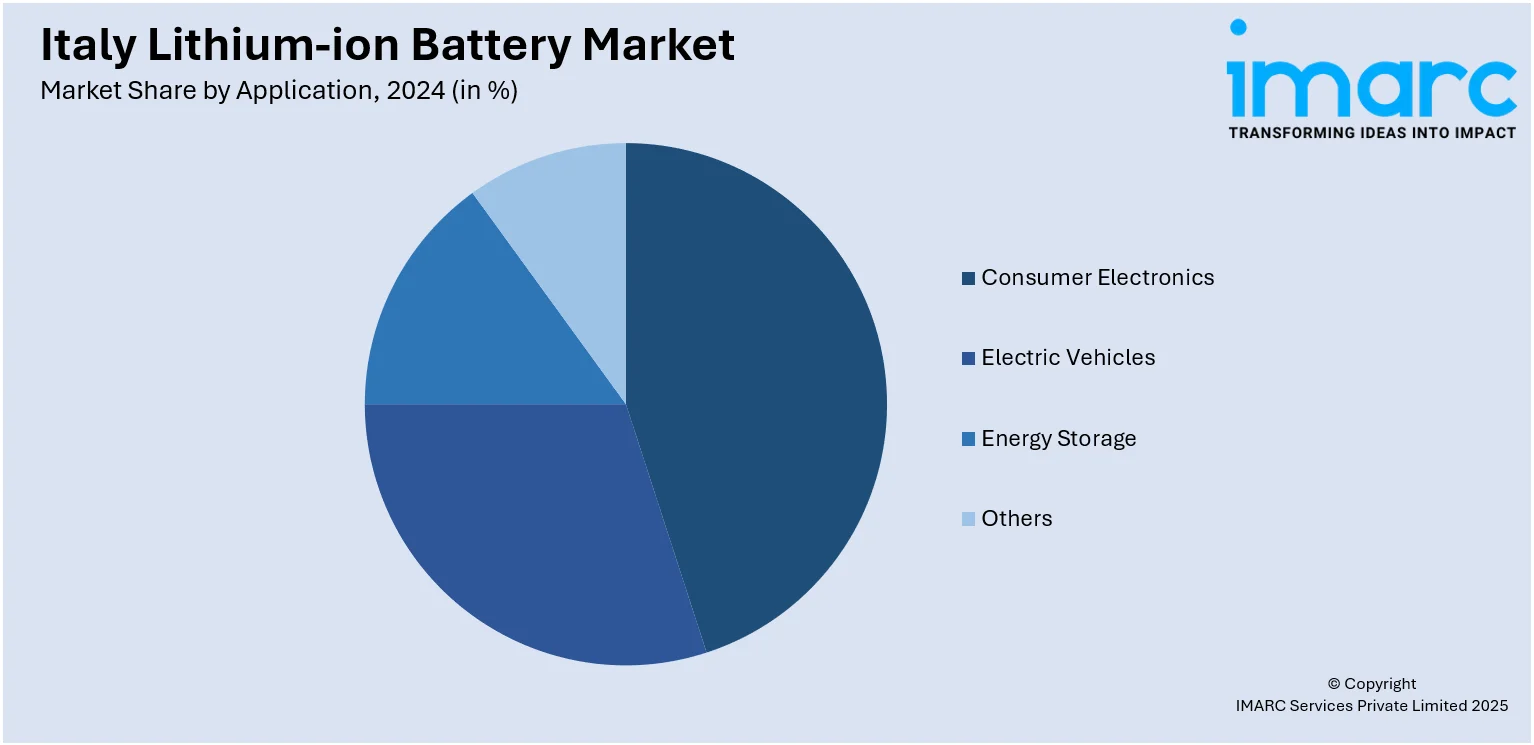
Italy Lithium-ion Battery Market Size, Share, Trends and Forecast by Product Type, Power Capacity, Application, and Region, 2025-2033
Italy Lithium-ion Battery Market Overview:
The Italy lithium-ion battery market size reached USD 1,252.62 Million in 2024. Looking forward, IMARC Group expects the market to reach USD 3,256.60 Million by 2033, exhibiting a growth rate (CAGR) of 11.20% during 2025-2033. Government incentives for EVs, growing energy storage needs, rising demand for sustainable transport, and increasing investments in domestic battery production are some of the factors contributing to the Italy lithium-ion battery market share. Supportive EU policies and expanding EV infrastructure also contribute to accelerating adoption and production growth.
|
Report Attribute
|
Key Statistics
|
|---|---|
|
Base Year
|
2024
|
|
Forecast Years
|
2025-2033
|
|
Historical Years
|
2019-2024
|
| Market Size in 2024 | USD 1,252.62 Million |
| Market Forecast in 2033 | USD 3,256.60 Million |
| Market Growth Rate 2025-2033 | 11.20% |
Italy Lithium-ion Battery Market Trends:
Recycling Infrastructure Gaining Ground
Investment is picking up in Italy’s battery recycling infrastructure, particularly for recovering critical raw materials like lithium, nickel, and cobalt. A new facility is under evaluation in Portovesme, aimed at processing battery waste from European sources. The operation would rely on an established metallurgical site in Sardinia and draw material through logistics and supply chains from Germany. One partner is contributing its proprietary hydrometallurgical recycling technology, while the other is leading the planning and financial backing. The goal is to close the loop on battery materials, support European self-sufficiency, and reduce environmental impact by reclaiming usable elements from battery scrap. A feasibility study is in progress to assess the economic and technical potential of the project. These factors are intensifying the Italy lithium-ion battery market growth. For example, in December 2024, Li-Cycle and Glencore resumed plans to explore a new lithium-ion battery recycling Hub in Portovesme, Italy. Glencore would lead and fund the study, using its Sardinian metallurgical complex. Li-Cycle would contribute technical support and its patented recycling tech. The facility would produce lithium, nickel, and cobalt from battery waste, supplied by Glencore’s network and Li-Cycle’s German facility near Magdeburg. A pre-feasibility study is underway.

To get more information on this market, Request Sample
Surge in Battery Manufacturing Capacity Near Naples
A major production facility for lithium-ion batteries is taking shape in southern Italy, with plans to support 8 GWh of annual output. A German systems supplier has been tapped to provide a complete electrode coating setup, reflecting a push toward self-sufficiency in energy storage components. The high-value investment underscores growing industrial commitment to large-scale battery manufacturing in the country, especially in regions with strategic logistics and skilled labor. The project marks a notable move in expanding the domestic supply chain for electric mobility and grid applications, aligning with broader European efforts to reduce dependence on external sources for key technologies. This points to a scaling-up of both infrastructure and ambition in the Italian battery sector. For instance, in December 2024, Germany’s Dürr Group secured a high-value order from Italian battery manufacturer FIB (part of Seri Industrial Group) for a lithium-ion battery production facility in Teverola, near Naples. Dürr would deliver a turnkey electrode coating system. The plant, valued in the high double-digit Million-Euro range, would support an annual production capacity of 8 GWh, marking a significant investment in Italy’s battery manufacturing sector.
Italy Lithium-ion Battery Market Segmentation:
IMARC Group provides an analysis of the key trends in each segment of the market, along with forecasts at the country and regional levels for 2025-2033. Our report has categorized the market based on product type, power capacity, and application.
Product Type Insights:
- Lithium Cobalt Oxide
- Lithium Iron Phosphate
- Lithium Nickel Manganese Cobalt
- Lithium Manganese Oxide
- Others
The report has provided a detailed breakup and analysis of the market based on the product type. This includes lithium cobalt oxide, lithium iron phosphate, lithium nickel manganese cobalt, lithium manganese oxide, and others.
Power Capacity Insights:
- 0 to 3000mAh
- 3000mAh to 10000mAh
- 10000mAh to 60000mAh
- More than 60000mAh
The report has provided a detailed breakup and analysis of the market based on the power capacity. This includes 0 to 3000mAh, 3000mAh to 10000mAh, 10000mAh to 60000mAh, and more than 60000mAh.
Application Insights:

- Consumer Electronics
- Electric Vehicles
- Energy Storage
- Others
The report has provided a detailed breakup and analysis of the market based on the application. This includes consumer electronics, electric vehicles, energy storage, and others.
Regional Insights:
- Northwest
- Northeast
- Central
- South
- Others
The report has also provided a comprehensive analysis of all the major regional markets, which include Northwest, Northeast, Central, South, and others.
Competitive Landscape:
The market research report has also provided a comprehensive analysis of the competitive landscape. Competitive analysis such as market structure, key player positioning, top winning strategies, competitive dashboard, and company evaluation quadrant has been covered in the report. Also, detailed profiles of all major companies have been provided.
Italy Lithium-ion Battery Market News:
- In June 2025, Germany’s BAM, alongside partners from Italy and France, started researching the safety of nanomaterials in lithium-ion batteries. The project targets risk assessment across the production, use, and disposal phases. Nanomaterials promise to boost battery energy density, cut charging time, and extend service life. The initiative aims to balance performance gains with safety, supporting the development of next-generation LIBs across Europe, including Italy’s evolving battery research landscape.
Italy Lithium-ion Battery Market Report Coverage:
| Report Features | Details |
|---|---|
| Base Year of the Analysis | 2024 |
| Historical Period | 2019-2024 |
| Forecast Period | 2025-2033 |
| Units | Million USD |
| Scope of the Report |
Exploration of Historical Trends and Market Outlook, Industry Catalysts and Challenges, Segment-Wise Historical and Future Market Assessment:
|
| Product Types Covered | Lithium Cobalt Oxide, Lithium Iron Phosphate, Lithium Nickel Manganese Cobalt, Lithium Manganese Oxide, Others |
| Power Capacities Covered | 0 to 3000mAh, 3000mAh to 10000mAh, 10000mAh to 60000mAh, More than 60000mAh |
| Applications Covered | Consumer Electronics, Electric Vehicles, Energy Storage, Others |
| Regions Covered | Northwest, Northeast, Central, South, Others |
| Customization Scope | 10% Free Customization |
| Post-Sale Analyst Support | 10-12 Weeks |
| Delivery Format | PDF and Excel through Email (We can also provide the editable version of the report in PPT/Word format on special request) |
Key Questions Answered in This Report:
- How has the Italy lithium-ion battery market performed so far and how will it perform in the coming years?
- What is the breakup of the Italy lithium-ion battery market on the basis of product type?
- What is the breakup of the Italy lithium-ion battery market on the basis of power capacity?
- What is the breakup of the Italy lithium-ion battery market on the basis of application?
- What is the breakup of the Italy lithium-ion battery market on the basis of region?
- What are the various stages in the value chain of the Italy lithium-ion battery market?
- What are the key driving factors and challenges in the Italy lithium-ion battery market?
- What is the structure of the Italy lithium-ion battery market and who are the key players?
- What is the degree of competition in the Italy lithium-ion battery market?
Key Benefits for Stakeholders:
- IMARC’s industry report offers a comprehensive quantitative analysis of various market segments, historical and current market trends, market forecasts, and dynamics of the Italy lithium-ion battery market from 2019-2033.
- The research report provides the latest information on the market drivers, challenges, and opportunities in the Italy lithium-ion battery market.
- Porter's five forces analysis assist stakeholders in assessing the impact of new entrants, competitive rivalry, supplier power, buyer power, and the threat of substitution. It helps stakeholders to analyze the level of competition within the Italy lithium-ion battery industry and its attractiveness.
- Competitive landscape allows stakeholders to understand their competitive environment and provides an insight into the current positions of key players in the market.
Need more help?
- Speak to our experienced analysts for insights on the current market scenarios.
- Include additional segments and countries to customize the report as per your requirement.
- Gain an unparalleled competitive advantage in your domain by understanding how to utilize the report and positively impacting your operations and revenue.
- For further assistance, please connect with our analysts.
 Request Customization
Request Customization
 Speak to an Analyst
Speak to an Analyst
 Request Brochure
Request Brochure
 Inquire Before Buying
Inquire Before Buying




.webp)




.webp)












